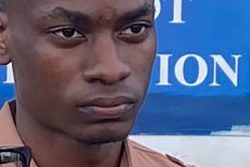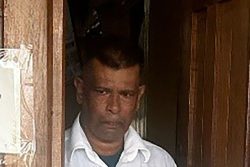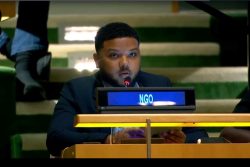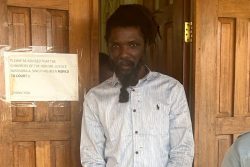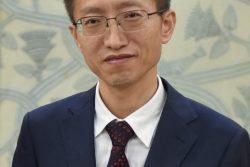Dear Editor,
I have trouble understanding the last letter by Dr Baytoram Ramharack (‘When does ethnicity transform into nationality?’ SN, November 9). It seems on a primary reading to have created a false dichotomy. It seems to have a conception of ‘being’ as disjunctive at the level of identity. It is either ethnic or national, I believe he is saying. My own feeling is that both these identities, the ethnic and the national, can co-exist in an ensemble or on a continuum. Not mutually exclusive at all.
Our own understanding of self-perception as a projection of identity is that it is layered. A person is simultaneously Guyanese, of Indian origin, of Hindu religion, socialist persuasion, etc. Islam has dealt with the question by treating all believers as “brothers” with all it implies, and rendering subordinate the other identity categories to which he may lay claim or is perceived to embody. The question posed by our racial cohabitation would therefore be: Do Indo-Guyanese Muslims prioritise their Muslim identity and judge others and themselves primarily as Muslims, or does the Indian aspect of their appurtenance take priority in some circumstances?
To respond briefly to Dr Ramharack according to our reading of his letter: Identity is multi-layered, but it is also situational in the sense that the identity we use varies with the ‘role’ (as a basic of social interaction) each situation demands. Identity therefore would vary depending on context. A person may privilege one or other aspect of his several identities. Identity use is also governed by time, in the sense that identity may evolve with temporal changes in the environment, due to circumstances changing the definitions, either geographical or legal, that fix identity. What it means to be Indo-Guyanese here at election time is not the same, in intensity and expectation, as it means to be Indo-Guyanese at the airport in Barbados or in Richmond Hill in New York. Identity then is transactional in the sense that in some contexts, one aspect of identity is prioritised by the person holding it or in the appreciation of others. A Guyanese at the airport in some Caribbean nations is identified as Guyanese in a transaction that brings with it all kinds of subjective considerations. Without tiring readers with details, one considers that the Nagamootoo statement of his identity was occluded by precisely the absence of explanatory responses that would have prevented the politically-inspired outrage from being immediately defused and diffused.
Dr Ramharack then makes the point that cultural assimilations like creolisation that dilute ethnic identities and may even eliminate some markers like language or cuisine, are tendencies that deprive us of the pure richness of our original cultures.
He refrains from giving any examples from the Indian experience here to show what positives have been lost with the modifications of the racial characteristics, and what has been gained in exchange. His essay also does not state explicity that the “original” cultures we claim to be defending may even have been, themselves, born of mixtures caused by contact, colonisation in the country of origin, religious conversion and other factors ceaselessly at work. His foundational idea seems to ignore that a Madrasi, having undergone Sanskritisation, or a Muslim of Hindu origin having adhered to Islam three or four generations ago, does not in any way represent on arriving here a primordial or unchanging culture, but represents a process of human exchange at a certain point in history. Even Hinduism, a dynamic religion in constant evolution, exists as an example of the unstoppable mutations within a culture or religion that has yielded many varieties of the same faith.
Having abstained from treating these issue Dr Ramharack rests his case on a single element of the idea of identity. It is ethnic and racial, and ignores internal variation (a lot of Christian Indians from a long time) and he dismisses the right of the current, or of coming generations, to opt for the modifications they freely choose to make. It deprives the individual of the freedom to select any of the range of possible identities available to him and seems to incarcerate him in a primordial and unchanging idea of Indianness.
A part of his letter makes reference to adjectives and phrases in mine. He seems to find unsavoury some words I use. No problem. As the man behind the keyboard I have granted myself a sort of poet’s licence to exaggerate, deform, etc, for effect. It is intended to enliven the text and represents a mode of thought for me.
I note in last week’s letter Ravi Dev makes the same point about my language, repeating a point about “polemics” he has made in the past. A person labelled Sultan Mohamed, writing in a paper that Ravi influences accuses me of treating Indians as “Interlopers”, a falsehood that Mr Dev does not find repugnant and threatening. One is reminded that some years ago he himself accused me of wishing for a “final solution” for Indians.
People over at the former Guyana Friends bulletin board, now known as Guyana Hoopla, have read the exchange and related letters. Tarron Khemraj, writing as TK states clearly that nowhere have I said Indians are ‘Interlopers’. The erudite Stormborn, blogging before as D2, like Carib J now writing as Carib NY also fails to find where in my letters I have attacked the Indian identity.
One needs to close by declaring that Guyanese of Indian origin who wish to re-create and practice an ‘Indianness’ of the type the newly arrived indentured servants brought, are of course free to do so. One notes that, as in the case of groups like the Amish in the United States, it could be done within the limits of the law. Some aspects of the condition, still strong in the homeland, such as caste, may have to be re-worked. I remark that some claim, defensively, that caste is all but forgotten. Mr Nagamootoo knows he is a Madrasi and has written a book that talks about it and has mentioned relations between Madrasis and other Indians as not always without prejudice. My own experience of caste consciousness among Hindus is that caste is only forgotten by those who have nothing to gain in remembering it. It still governs, in many cases, access to the functions of pandithood and marriage choice when caste is a positive attribute.
Nowrang Persaud writing a few days ago reminds one that he is a Brahmin. Mohabir Anil Nandlall, the Attorney General, has not forgotten that he is Kshatriya and nor did Balram Singh Rai about whom Dr Baytoram wrote a book. Chamars, a low caste group, have less incentive to crow about their original condition since the only one I knew who mentioned it was a Chrtistianised handyman called Singh who would, when drunk, weep his bad luck and karma for having been born within that caste. So, in calling for a return to identity it would be useful to see exactly what Dr Ramharack and others would require as information to be printed on the new Indo-Guyanese identity card that would, in the Republic planned by ROAR need to be carried around. Even now the “original identity” is irretrievably lost, concealed, rejected, reworked and beyond recovery for many.
Yours faithfully,
Abu Bakr
